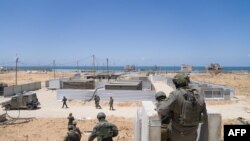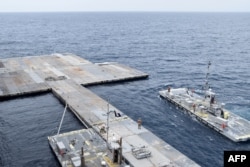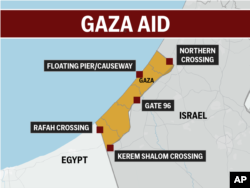"This morning, just a few hours ago, the pier was successfully affixed to the beach in Gaza. In the coming days, we will commence the delivery of aid," U.S. Vice Admiral Brad Cooper told reporters Thursday.
Cooper said about 500 tons of humanitarian assistance have been loaded onto ships, with thousands of tons more ready to be added to the distribution queue once that aid is distributed.
“We are focused on flooding the zone with humanitarian assistance … to complement the provision of aid through land routes, which we know is the most efficient and effective pathway to move the necessary volume of assistance,” he said.
The new maritime corridor has several parts, with aid first undergoing inspection and security checks in Cyprus. Loads are then being taken to a U.S.-built floating platform off the Gaza coast and transferred onto trucks, with smaller boats taking the trucks to the newly anchored pier that juts out several hundred meters from the Gaza coastline.
Distribution
Each boat can transfer between five and 15 trucks to shore. Once fully operational, the pier will be able to provide about 150 truckloads of aid to Gaza per day, according to U.S. officials.
The United Nations will be in charge of receiving shipments and coordinating distribution on the ground. The arrangement is part of an effort to boost what humanitarian organizations say is a vastly insufficient amount of aid for Palestinian civilians.
“The American corridor is absolutely essential to helping meet this gap in need to address the shelter, the food, the health, malnutrition and clean water sanitation needs,” said Sonali Korde, assistant to the administrator of USAID’s Bureau for Humanitarian Assistance.
United Nations spokesman Farhan Haq reiterated on Thursday that the maritime corridor is not the best solution.
“Getting aid to people in need into and across Gaza cannot and should not depend on a floating dock far from where needs are most acute. Land routes are the most viable, effective and efficient aid delivery method, which is why we need all crossing points to be opened,” Haq said.
Korde said the international community must continue to work on pushing more aid through all routes into Gaza.
“We're at a point in time when this is all hands on deck. We can't spare any effort,” she told reporters.
Haq also raised fears Thursday that without fuel on the ground in Gaza, aid workers will not be able to distribute the humanitarian assistance coming from the pier. Korde, however, told reporters that USAID expects to "have the fuel necessary” for the operation.
Aid has been slow to get into Gaza due to long backups of vehicles at Israeli inspection points. The United States and other nations have air dropped food into Gaza 38 times in recent months, but each air drop via military accounts for only about one to three truckloads of food, a U.S. official told VOA.
Aid organizations have said several hundred truckloads of food are needed in Gaza each day.
The pier’s completion was delayed for several days due to rough seas.
Security
Security for the approximately 1,000 U.S. forces building the pier and aid organizations distributing the supplies has been the paramount concern for the Pentagon since the plan’s conception, according to Cooper.
"This is a 100% humanitarian mission, and any attack on those working on it is an attack on aid for the people of Gaza, " said Cooper.
Security forces have conducted rehearsals in preparation for the commencement of operations and will continue to assess and reassess security, Cooper said.
Israel Defense Forces have dedicated a brigade of troops, along with ships and air assets, to help ensure force protection. IDF engineers prepared the beach for the temporary pier and secured it to the beach.
Israel attacked Hamas in Gaza following Hamas’ October 7 terror attack on Israel, which killed 1,200 people and saw hundreds more taken hostage.
In the nearly seven months since the attack, more than 34,000 Palestinians have been killed in Gaza, according to Gazan health officials.


